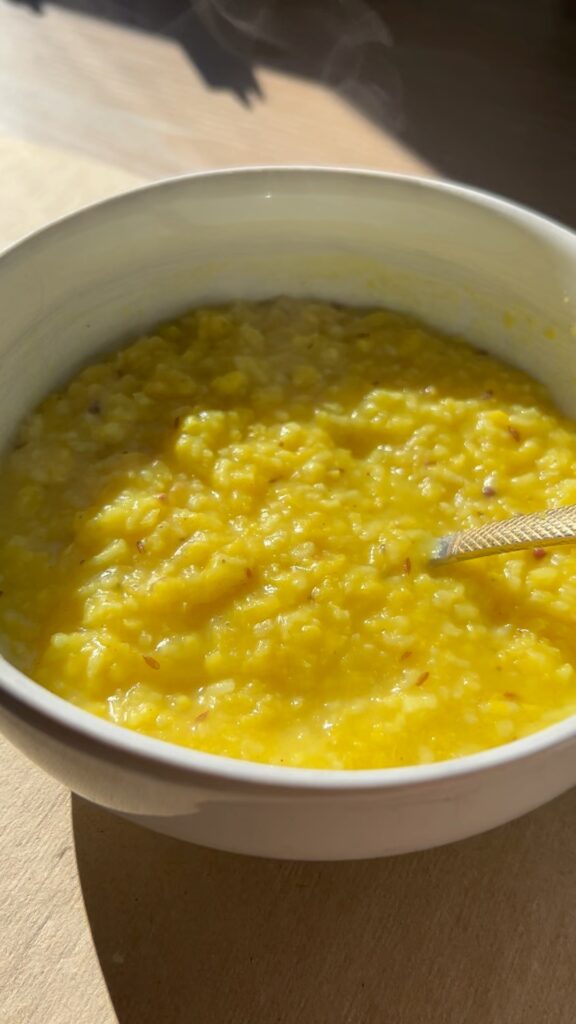Inspired by the dynamic duo of Dr. Roizen and Chef Jim at the Cleveland Clinic, where I interned last summer, I’m embarking on a mission to introduce culinary medicine in an accessible way – through social media. Every Friday, I’ll be sharing a “Functional Foodie” recipe as part of my job as Patient Care Navigator at Princeton Integrative Health.
In the past couple weeks, I’ve been doing a lot of traveling and when I come home, I’ve been craving one thing: kitchari. As you might know already, I’m passionate about integrative medicine and as part of that, traditional philosophies on healing. Kitchari, meaning “mixture” (generally of grains and legumes), plays a fundamental role in the Ayurvedic lifestyle.
Ayurveda is a holistic system of medicine that originated in ancient India and has been practiced for thousands of years. Central to Ayurveda is the concept of the doshas, which are fundamental energies or principles that govern various physiological and psychological functions in the human body. There are three primary doshas: Vata, Pitta, and Kapha, each of which represents a unique combination of elements (air, fire, water, earth) and qualities. These doshas influence an individual’s physical constitution, personality, and overall well-being. The balance of these doshas is considered crucial for maintaining good health, while imbalances can lead to ailments and diseases. Ayurvedic practitioners use personalized assessments to determine a person’s dosha constitution and recommend dietary, lifestyle, and therapeutic interventions to restore harmony and balance within the body.
Kitchari, made from a combination of basmati rice and mung dal, it boasts a wide array of interpretations, reflecting the diverse needs of the cooks who prepare it. It serves as a wholesome and easily digestible source of strength and vitality, nurturing all bodily tissues. In Ayurveda, kitchari is the favored sustenance for those undertaking a cleansing program. Of course, you can enjoy this a bit more richly, as I do, with more ghee and sometimes roasted cashews.
Patients are oftentimes looking for an easy, one-pan dish. This is super comforting, delicious, nourishing, and flexible. What’s there not to like?
- Mung beans. Mung beans bring the protein to this dish, with 1 cup of cooked mung beans having 14 grams. Mung beans have been associated with heart health due to their potential to lower cholesterol levels. The soluble fiber and phytonutrients in mung beans may contribute to reducing LDL cholesterol, thereby decreasing the risk of cardiovascular diseases. These legumes are also a notable source of essential nutrients such as folate, potassium, and magnesium. Folate is vital for DNA synthesis and repair, while potassium and magnesium play key roles in maintaining healthy blood pressure and supporting various physiological function. [1]
- Good quality white basmati rice. Interestingly, white basmati tends to have lower concentrations of arsenic than brown rice because arsenic accumulates in rice bran. White basmati rice offers a quick source of energy, is easy to digest, and is naturally low in fat and sodium, making it suitable for various dietary preferences. I like this brand.
- Ghee. Ghee is clarified butter with a high concentration of butyric acid. This short-chain fatty acid has been linked to potential anti-inflammatory and gut health benefits. It can help improve the absorption of fat-soluble vitamins like A, D, E, and K, found in the other ingredients of this soup. [2] Ghee is used in Ayurveda, the traditional system of medicine that originated in India, and is considered to have a moisturizing property, making it especially ideal for the dry fall.
To make this recipe vegan, you can swap ghee with extra virgin olive oil, which we all know and love.
KITCHARI, GF (V option)
Serves 2
Ingredients
- 1/2 cup basmati rice
- 1 cup mung dal (split yellow)
- Approximately 6 cups water
- 1 inch ginger root, chopped or grated
- 1 tsp salt
- 1 tbsp ghee
- 1/2 tsp coriander powder
- 1/2 tsp cumin powder
- 1/2 tsp whole cumin seeds
- 1/2 tsp mustard seeds
- 1/2 tsp turmeric powder
- 1 pinch asafoetida (hing)
- Handful of fresh cilantro leaves
- 1 and 1/2 cups assorted vegetables (optional, like zucchini, spinach, carrots)
Instructions
- Carefully pick over the basmati rice and mung dal to remove any stones. Wash each separately in at least two changes of water.
- In a large pot, add the washed rice and mung dal and 6 cups of water. Cover the pot and cook until the mixture becomes soft, which should take about 20 minutes.
- While the rice and dal are cooking, prepare the vegetables if you’re including them in the recipe. Cut the vegetables into smallish pieces.
- Add the prepared vegetables to the cooked rice and dal mixture and continue to cook for an additional 10 minutes.
- In a separate saucepan, heat the ghee and sauté the whole cumin seeds and mustard seeds until they start to pop.
- Add the chopped or grated ginger and the other spices (coriander powder, cumin powder, turmeric, and asafoetida) to the saucepan. Stir the spices together to release their flavors.
- Stir the sautéed spice mixture into the cooked dal, rice, and vegetable mixture. Add the pinch of mineral salt and chopped fresh cilantro.
